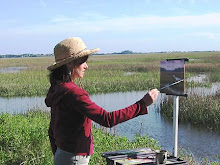Planning a painting
A sketch need not be overly detailed, but it is still helpful in order to figure out the placement of things. Where is my horizon line? Where is my center of interest? Where is the sun in relation to my subject, and where will the shadows fall? What from the scene do I feel is important, and what may I want to edit out completely?
A sketch is also helpful because my canvas proportions may be different from the proportions in my photo. Therefore, I have to think about how to crop a scene to make it most interesting. Here is a photo of a scene in the Luberon valley of Provence that I took when I was there painting on location. A lovely little church served as a backdrop for a beautiful cherry orchard strewn with pink and white wildflowers. The photo does not do justice to the gorgeous wildflowers that were in this scene, but since I was there and painted and sketched in this area, memory can serve me well here:

Here is my very quick sketch. I plan to eliminate one of the middle ground trees, and use the two foreground trees to frame the scene. I establish where my horizon line will fall. At this point I am thinking it will be more interesting to have the horizon line a little higher up in my scene, rather than right smack in the middle of my canvas. Having my center of interest (the church) just off to the left of center creates a more dynamic composition as well. I also establish my light source and determine shadows.

Here is the painting, pretty well laid out. It is 12x16". It's been snowing here so the lighting coming in my studio windows has not been great for photography and this photograph has dulled my colors somewhat. I'm still working out the distant trees and the grasses and wildflowers in the foreground. I will post the completed painting on my website in the Provence Paintings section when it is complete.

Jennifer Young; Vibrant Landscapes
www.jenniferyoung.com
Contact


0 Comments:
Post a Comment
<< Home